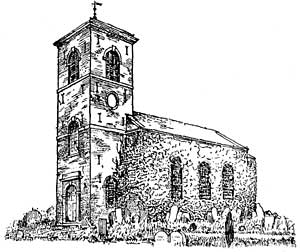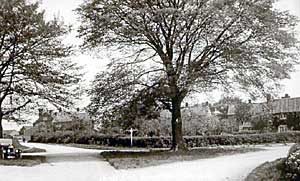Elizabeth and John Sothill, who as was stated last week, successfully resisted a relative's claim to their manor at Kinoulton, demised it to the notorious Sir R. Empson for life, and his daughter wedded the Sothill heir, but upon the accession of Henry VIII Empson was to the joy of the nation beheaded. Joan, daughter of Sir John Rocliffe and his Empson wife, inherited the lordship and took it in marriage to Sir John Constable, making their seat at Kinoulton.
Upon Sir John's decease in 1500 these lands and tenements descended to their daughters, Cecily, whose second husband was an Oglethorpe, and Anne, who married Sir Anthony Thorold.
Once again the property passed by female descent for Anthony's daughter, to whom it descended, wedded George Clifton, their son was "Sir Gervase the gentle," who purchased the Oglethorpe share, and, becoming lord of almost the whole of the village, lived until 1587.
Meanwhile others obtained portions of the parish. Richard Truthall died in 1512, seized of a toft and 60a of pasture, some of which he had enclosed by 1492. Sir Thomas Kitson, of London, acquired the manor of Colston Basset, and with it valuable appurtenances, and Thomas Hutchinson, who had already a parcel of land, held from Kitson three enclosures of meadow on lease for 40 years dating from 1532. In 1539 Sir Thomas sued "John Truthayl, gentleman," for detention of property deeds and in the following year Harold Rosell purchased Herteswell Grange, late of Swineshead Abbey, passing it three days later to Sir John Constable. Sir Bryan Stapleton, at his death in 1550, had property here pertaining to his manor of Bingham, and in that year "William Hutchinson, yeoman, of Owthorpe," left bequests to neighbouring villages, the poor of Kinoulton receiving 4s. The Hutchinsons were destined to figure prominently in the local annals in the following century.
KINOULTON PALACE?
Local tradition has it that "the Bishop" meaning Archbishop Cranmer who was martyred in 1553, had a, palace at Kinoulton in which he resided as Bishop of Llandaff. We are told that it stood close beside the old church on the hill, that it was subsequently converted into a grange, and that about 150 years ago, its stone path to the church was uncovered.
Local legends sometimes embody facts otherwise lost, but in this instance, any factual basis for the story is deeply overlaid with fiction. Cranmer never held the Welsh see and, if the county had more ecclesiastical palaces than those at Southwell, Scrooby and Laneham, something would be known of them. It is perhaps possible to see how the tradition arose. "Cranmere" was an old local field-name and the archbishop was born at Aslockton not far away.
If there were palaces at Southwell, Scrooby and Laneham why not one here, and, if so, was not Cranmer to be linked with it? Moreover, when Swineshead Abbey was suppressed in 1539, Harold Rosell had purchased its grange—Herteswell Grange—promptly selling it to Sir John Constable, and, Harold had married Cranmer's sister. Here then, were the ingredients for the tradition; distorted memory has muddled them up and hence the tale. The building in question may well have been an ancient manor-house which, as was so often the case, descended to the status of a farmstead, or it may have been the home of the local servants of the monks of. Swineshead.
IN ELIZABETH'S TIME.
Under Elizabeth, the Kitson property went, with Colston Basset manor, by sale to the Goldings; the Hutchinsons had a farm, doubtless at Lodge; the Hackers had a messuage with land, and a farm which had belonged to Thurgarton Priory was sold to two laymen by the Queen. The villagers lived up to the tradition of "Merrie England" for it maintained a company of dancers which entertained the district and in 1572 performed before the mayor at Nottingham for which it was rewarded with 12d.
A record of 1602 tells of a wedding celebrated in the church without banns or licence at 4 o'clock in the morning. The bridegroom paid the parson 6s. 8d. and no inconvenient questions were asked.
During succeeding generations other hasty weddings were celebrated in the church, but generally by licence of the vicar who was invested with that right.
THREATENED BY PLAGUE.
When Colston Basset, was so severely visited by plague in 1604 that, it had to be isolated from outside contact, the inhabitants of Kinoulton must have greatly feared infection and about that time the Saviles, who had once bought the Oglethorpe property, had a mansion here which was in their occupation in 1609.
With Col. Hutchinson's home at Owthorpe so near, and with the adjoining Colston Basset, the seat of the papist Goldings who fought strenuously for Charles throughout the Civil War, the peace of Kinoulton must often have been imperilled, but for incident we must turn to the Lodge, which lay on the Fosseway, the road so sunken that it is said an army might pass unobserved.
After the final rising in aid of the imprisoned king was defeated at Preston in 1648, the vanquished cavaliers fled in groups, one of which, headed by the gallant Sir Marmaduke Langdale, made towards Newark, hoping maybe to escape abroad by means of the Trent Langdale was familiar with this district, having battled in it, once heading a force for the relief of Newark.
Mrs. Hutchinson narrates how his little party of 10 came in disguise to an alehouse upon her husband's land and gave out that they were Cromwell's men. No more sequestered spot than this lonesome tavern could have been found, but their presence excited suspicion; Major Widmerpool two miles away was informed and news was hurried to Col. Hutchinson that strange visitors were resting at his "lodge."
Both leaders hastened with supporters to intercept the fugitives, but Widmerpool arrived first and placing a guard upon the stabled horses, surrounded the Inn and compelled Sir Marmaduke to surrender.
His exploits had so angered Parliament that he had been excepted from all mercy. He was hurried captive to Nottingham Castle, but by bribing his gaoler, who escaped with him, he evaded the fate in store for him. Tricked out as a roundhead soldier, he was fortunate enough to reach safety and lived to witness the Restoration. His captors at Lodge-on-the-Wolds were rewarded by the gift of the cavaliers' horses and to Hutchinson was given "a case of two very fine pistols."
LATER STUART DAYS.
Under the Commonwealth the rectory was taken from the York See and leased to Sir Gervase Clifton, who in 1650 was receiving its profits of £70; the vicarage was worth £30 a year and the parson preached at least once and sometimes twice each Sunday. He was vicar by 1644 and retained the living until his death about 1674. In 1676 his successor reported 102 adult parishioners, none of whom refused the Sacrament, but in the same year Wm. Poole of "the lodge" suffered distraint for attending a Quaker conventicle.
The last year of the reign of Anne witnessed the sale by the Goldings of Colston Basset manor, and with it passed to the Earl of Strafford their property here. A decade later, Stukeley wrote that "at the lodge was an inn under a great wood." The Roman pavement of blue flagstones laid edgewise, taken from the hillside, was very visible, but it had been plundered of some of its stone, and the inn yard was paved with them.
The vicar of 1743 advised his archbishop that the parish had 32 families and informed him how "by honest and persuasive methods, cool and mild Reasoning, and by the Cogency as well as the Authority of Scripture," he had induced an errant dissenter to return to the fold. He added that a village school was contemplated, and assured him that as "judge of the Peculiar" he did not abuse his power. He preached here once each alternate Sunday, and at Owthorpe, where he was curate, on the other.
THE SPA.
By 1769 Kinoulton was becoming famous for the medicinal quality of the water of a spring on the hill west of the village. Its chaly-beate output, it was then said in a London newspaper, "is clear, pleasing, cooling, and a little saltish." Fifty years later, it was a reputable spa both for drinkers and bathers and bathing and dressing-room accommodation had been provided for patrons. As Spa Well, the spring still exists.
THE ABANDONED CHURCH.
 |
| Kinoulton church. |
In 1793, when the Grantham Canal was being cut through the parish, the ancient church on the hill was superseded by the present brick structure built by the Earl of Gainsborough up on or near to the site of old Newbold church. Kinoulton Church has been abandoned since 1780 as too ruinous for use, public worship being conducted in a barnlike building which seems never to have been consecrated. Portions of the ground-plan, still discernible, of the venerable church itself suggest that it was small and comprised a chancel, nave, western tower and a side-aisle with a porch.
In the following year, Cropwell Butler and Kinoulton conjoined, had to pay a fine of £23 11s. for failing to produce its "volunteer" for the French war in accordance with an Act of 1796. In 1796, the parish had 25 houses subject to inhabited house duty which, however, was not levied on farmhouses rented at less than £10 a year or private, dwellings under £5. The abdication of Napoleon and his consignment to Elba in 1814 was fervently celebrated by the villagers and a long account of it, written by the vicar at that time, tells how on a hot July day feasting (with abundance of plum-pudding and ale) prevailed from dawn to dusk, with bands parading, bells clanging, and dancing on the green, the final item being the production of an effigy of "Boney," which was prophetically committed to the flames of a huge bonfire.
A century ago, the manor had descended to Henry Neville, who assumed the name and arms of the Noels, Earls of Gainsborough, and in 1847 that gentleman erected a village school. Labourers were then earning but 10s. a week and it is not surprising to read that poverty abounded. As a curiosity it may be mentioned that in 1889 there were living in the parish a married couple each of whom were over 100 years of age—a probable record for such double longevity.
A GILBERTIAN POSITION.

The east end of Kinoulton in the 1930s.
In 1896 it was reported to the County Council that at Lodge-in-the-Wolds the only voter and ratepayer, who was also the owner and occupier of the whole of its 36 acres, had to fill the office of overseer, act as the parish meeting, parish constable, and fill all the other customary parochial offices. Upon one occasion, the Justices had to hold a special session for the reception of its jury list, although the only person liable for jury service was this owner himself and he was exempt through old age. Soon afterwards the tiny parish was amalgamated with Cotgrave for civil purposes, but ecclesiastically it remained extra-parochial.
At the last census Kinoulton's population was 285—10 more than 130 years earlier, and in 1940 died here Arthur Lowe, an artist of some repute.
